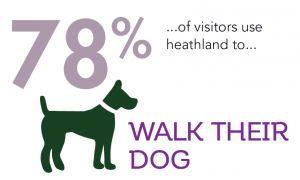Take the Lead on the Heath
78% of visitors to our heathland sites are accompanied by their dogs. Heathland is a wonderful location for dog walking, offering open spaces away from traffic, but dogs straying from the path can threaten the success of ground nesting birds and may scare / injure livestock, whilst dog poo adds unwanted nutr ients to the soil.
ients to the soil.
From March to September 2017 over half a million people engaged with the ‘Take the Lead’ campaign through Facebook, Twitter, Instagram and YouTube. In October 2017 the Heathlands Reunited project launched a pilot project recruiting Dog Ambassadors who will assist in educating people and encouraging responsible dog ownership to help protect and preserve this beautiful habitat, allowing everyone to safely share this space. With assistance from ‘Natalie Light Dog training’ ambassadors will be given full training and receive ongoing support. Find out how to become a dog ambassador.
The Heathlands Reunited project team have also developed a ‘Countryside Ability’ dog training course that they take to a range of public events across the project area. The course is a spoof on countryside agility and covers all four of the campaign key messages. Owners are asked to recall their dog, walk through a field of fake sheep responsibly, pick up their poo and avoid the ground nesting temptations. Everybody receives a certificate graded at bronze, silver or gold.
Owners who walk on heathlands site can also sign up to our I Take The Lead Pledge, which will be available to sign up to at our Heathlands Reunited events. Anyone who signs up will feature in the I Take The Lead Gallery.
Why?
Grazing is an important management technique used on heathlands sites. The cattle found on heathland site are bred very selectively and undergo tests before they are put out to graze on the heaths. Their temperaments are checked so they are ‘wild’ enough that they won’t approach people but tame enough to recognise people and dogs are not a threat. Always keep your dog on a lead around livestock. If an incident should occur we advise owners to take the dog off the lead, or to drop it so you can get out of harms ways.
Sticking to the path during ground nesting bird season not only protects some of our rarest ground nesting birds but keeping your dog in sight may also prevent them stumbling across an adder or picking up potentially dangerous military debris.
Usually recognisable by the signage, MOD danger areas are off limits at certain times. Do not enter the danger areas when the red flags are flying. Training manoeuvers could include larger machinery and sometimes even live firing. It’s not always obvious that something is going on as soldiers are camouflaged, so don’t be tempted to jump the fence. You could give away the other sides positioning and cause the whole military training exercise to come to a halt.There are plenty of alternative sites you can visit without risking your own, and your dog’s life.
When the flags are down you are free to enter the danger zones and use the paths. When training in these areas soldiers will crouch, crawl and roll on the floor. Let’s share this space responsibly so it remains open for future generations to enjoy and help make sure the soldiers don’t get covered in dog do.
Always bag and bin your dog poo. Dog poo contains worms and germs. It is different to cow pat, sheep and rabbit poo as dogs are fed food which is not from the natural environment that they then poop in. If left to decompose the poo changes the natural PH of the heathlands soil and adds nutrients to the ground causing invasive plants to thrive and out compete the heather. This isn’t the only reason…..
Harmful parasites are also found in the poo, they will enter the soil which can cause worms and diseases to be passed onto humans and even livestock causing serious illness. This also has a detrimental effect on local water tables, contaminating lakes, ponds and drinking water. It is not a good fertiliser and should always be picked up.
If you don’t want to add plastic to the environment try using compostable bags, ideally made from corn starch- the type you use for your compost bin at home. There are also various items you can buy to store your poo on your walk until you find a bin.
